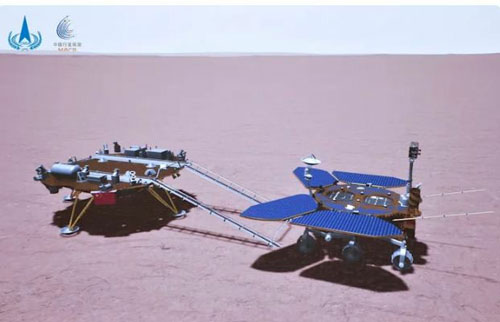Beijing
China has become only the second nation to ever drive a rover on Mars, joining the US.
After successfully touching down on the red planet on May 15, the Chinese National Space Administration’s Zhurong rover sat tight on its landing pad, charging up as its solar panels soaked in energy from the sun.
On Saturday, the rover – named after a god of fire in Chinese mythology – finally left its lander behind. At 10:40 am Beijing time, Zhurong rolled down a ramp and onto the Martian surface, according to a post on the rover’s social media account, Reuters reported.
According to China’s state media outlet, Xinhua, the rover then completed its first test drive, “leaving the country’s first ‘footprints’ on the red planet.”
The mission that brought Zhurong to Mars is called Tianwen-1, meaning “questions to heaven.” It’s the first Mars mission ever to send a spacecraft into the planet’s orbit, drop a landing platform onto the Martian surface, and deploy a rover all in one expedition.
The Tianwen-1 lander carried Zhurong inside of it down to Mars’ Utopia Planitia – a giant plain in the planet’s northern hemisphere.
Now that it’s ready to roll, Zhurong will explore the plain and search for underground water ice, while also capturing 3D images of the surface and examining the chemical make-up of Martian soil.
Utopia Planitia is a vast field of ancient volcanic rock that may have extensive reserves of water ice beneath its surface.
If space agencies like NASA and CNSA send humans to Mars one day, water would be a crucial resource because it can both sustain astronauts and get broken down into hydrogen and oxygen for rocket fuel.
It’s unlikely Mars-bound spaceships could carry enough water, oxygen, and hydrogen for the entire journey there and back.
On Wednesday, China released Zhurong’s first photos from the red planet. The color image below, taken by the rover’s navigation camera, shows Zhurong’ sitting atop the Tianwen-1 lander with its solar panels unfolded.
Zhurong becomes the sixth rover ever to successfully operate on Mars. In the last 24 years, NASA landed and drove five rovers.
The Soviet Union managed to land a rover in 1971, but lost contact with it before the mission could begin.
At 530 pounds, Zhurong is about the size of the twin Spirit and Opportunity rovers NASA put on Mars in 2004.
Zhurong has about 90 days to study the red planet. (That’s its official mission timeline, but Spirit and Opportunity had the same three-month window and ended up exploring Mars for six and 14 years, respectively.)
The Chinese rover can move about 656 feet (200 m) per hour, and drive up and over obstacles that are a foot tall, Xinhua reported.
What makes Zhurong unique, however, is its active suspension system. NASA’s rovers, including Perseverance, use a passive suspension system called rocker-bogie, which helps the vehicles put the same amount of weight on each of their six wheels. This minimizes how much the rovers tilt over uneven terrain.
But each of Zhurong’s six wheels can be controlled independently, and its active suspension system may adjust how much weight needs to go on each wheel to help rover climb steeper slopes or obstacles.
“It could help the rover get out of trouble” if Zhurong encounters loose sandy soil or densely distributed rocks, Jia Yang, deputy chief designer of the Tianwen-1 mission, told Xinhua.
Now that the Tianwen-1 lander and Zhurong rover have reached Mars, NASA’s Perseverance rover and Ingenuity helicopter are no longer the red planet’s newest arrivals.
Perseverance touched down on Mars three months ago carrying Ingenuity, in part of the planet called the Jezero Crater.
It’s unlikely China and the US’s rovers will ever cross paths. While both Utopia Planitia and the Jezero Crater are in Mars’ northern hemisphere, the distance between the two landing sites is about 1,000 miles.—AP










